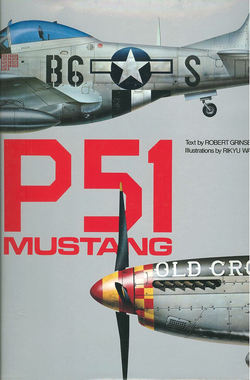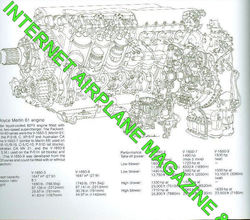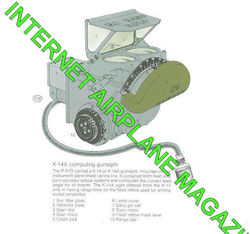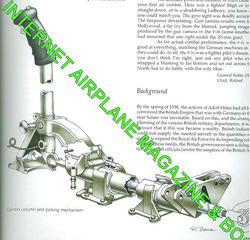P-51 MUSTANG HBDJ NORTH AMERICAN FG USAAF RAF WW2 ROLLS-ROYCE MERLIN WATANABE
TEXT BY ROBERT GRINSELL / ILLUSTRATIONS BY RIKYU WATANABE
INTRODUCTION / BACKGROUND
SUPER DETAILED ILLUSTRATIONS (K-14A COMPUTING GUNSIGHT, CONTROL COLUMN AND LOCKING MECHANISM, RADIATOR AIR SCOOP, DROP TANK INSTALLATION, FUEL SELECTOR SWITCH, BOMB RACK, HAMILTON STANDARD ADJUSTABLE-PITCH CONSTANT SPEED PROPELLER, BROWNING M2HB HEAVY BARREL MACHINE GUN, ENGINE CONTROL THROTTLE QUADRANT, RUDDER PEDAL ASSEMBLY, TAIL GEAR ASSEMBLY
PROTOTYPE NORTH AMERICAN NA-73X, XP-51 APACHE, P-51-NA, A-36A INVADER, P-51A, P-51B, P-51C, P-51D, P-51F, P-51G, P-51H, P-51J, P-51K, P-51L, P-51M, P-82 TWIN MUSTANG
ROLLS-ROYCE MERLIN 61 12-CYLINDER LIQUID-COOLED ENGINE / PACKARD MERLIN 60 V-1650-3
ROYAL AIR FORCE RAF
FOUR PAGE FOLDOUT POSTER: P-51B “OLD CROW” 357TH FG MIGHTY 8TH AF BUD ANDERSON
COLOR PROFILES – WW2 FG USAAF
TWO-PAGE FOLD OUT COLOR POSTER: AIR RACER P-51 MUSTANG
POSTWAR MUSTANGS
FOREIGN PRODUCTION (COMMONWEALTH AIRCRAFT AUSTRALIA)
P-51D MUSTANG CUTAWAY CENTERFOLD ILLUSTRATION
COMBAT OPERATIONS
FULL PAGE P-51D COCKPIT DIAGRAM
--------------------------------------------------------------------------------------
Additional
Information from Internet Encyclopedia
The North American Aviation P-51 Mustang
is an American long-range, single-seat fighter and fighter-bomber used during
World War II, the Korean War and other conflicts. The Mustang was conceived,
designed and built by North American Aviation (NAA) in response to a
specification issued directly to NAA by the British Purchasing Commission. The
prototype NA-73X airframe was rolled out on 9 September 1940, 102 days after
the contract was signed and first flew on 26 October.
The Mustang was
originally designed to use the Allison V-1710 engine, which had limited
high-altitude performance. It was first flown operationally by the Royal Air
Force (RAF) as a tactical-reconnaissance aircraft and fighter-bomber (Mustang
Mk I). The addition of the Rolls-Royce Merlin to the P-51B/C model transformed
the Mustang's performance at altitudes above 15,000 ft, matching or
bettering that of the Luftwaffe's fighters. The definitive version, the P-51D,
was powered by the Packard V-1650-7, a license-built version of the Rolls-Royce
Merlin 60 series two-stage two-speed supercharged engine, and armed with six
.50 caliber (12.7 mm) M2 Browning machine guns.
From late 1943,
P-51Bs (supplemented by P-51Ds from mid-1944) were used by the USAAF's Eighth
Air Force to escort bombers in raids over Germany, while the RAF's 2 TAF and
the USAAF's Ninth Air Force used the Merlin-powered Mustangs as
fighter-bombers, roles in which the Mustang helped ensure Allied air
superiority in 1944. The P-51 was also in service with Allied air forces in the
North African, Mediterranean and Italian theaters, and saw limited service
against the Japanese in the Pacific War. During World War II, Mustang pilots
claimed 4,950 enemy aircraft shot down.
In early 1943 the USAAF also decided that the Republic
P-47 Thunderbolt and P-51B be considered for the role of a smaller escort
fighter and, in July a report stated that the P-51B was "... the most
promising plane ..." with an endurance of four hours 45 minutes with the
standard internal fuel of 184 gallons plus 150 gallons carried externally. In
August a P-51B was fitted with an extra internal 85 gallon tank and, although
there were problems with longitudinal stability and some compromises in
performance with the tank full, it was decided that because the fuel from the
fuselage tank would be used during the initial stages of a mission, the fuel
tank would be fitted in all Mustangs destined for VIII Fighter Command. The P-51 Mustang was a solution to the clear
need for an effective bomber escort. The Mustang was at least as simple as
other aircraft of its era. It used a common, reliable engine and had internal
space for a huge fuel load. With external fuel tanks, it could accompany the
bombers all the way to Germany and back. Enough P-51s became available to the
8th and 9th Air Forces in the winter of 1943-1944.
The P-51 was a relative latecomer to the Pacific Theater.
This was due largely to the need for the aircraft in Europe, although the
P-38's twin-engine design was considered a safety advantage for long over-water
flights. The first P-51s were deployed in the Far East later in 1944, operating
in close-support and escort missions, as well as tactical photo reconnaissance.
As the war in Europe wound down, the P-51 became more common: eventually, with
the capture of Iwo Jima, it was able to be used as a bomber escort during
Boeing B-29 Superfortress missions against the Japanese homeland.
In 1947, the newly formed USAF Strategic Air Command
employed Mustangs alongside F-6 Mustangs and F-82 Twin Mustangs, due to their
range capabilities. In 1948, the designation P-51 (P for pursuit) was changed
to F-51 (F for fighter), and the existing F designator for photographic
reconnaissance aircraft was dropped because of a new designation scheme
throughout the USAF. Aircraft still in service in the USAF or Air National
Guard (ANG) when the system was changed included: F-51B, F-51D, F-51K, RF-51D (formerly F-6D),
RF-51K (formerly F-6K), and TRF-51D (two-seat trainer conversions of F-6Ds). They remained in
service from 1946 through 1951. By 1950, although Mustangs continued in service
with the USAF after the war, the majority of the USAF's Mustangs had become
surplus to requirements and placed in storage, while some were transferred to
the Air Force Reserve (AFRES) and the Air National Guard (ANG).
From the start of the Korean War, the Mustang once again
proved useful. A substantial number of stored or in-service F-51Ds were
shipped, via aircraft carriers, to the combat zone and were used by the USAF,
and the Republic of Korea Air Force (ROKAF). The F-51 was used for ground
attack, fitted with rockets and bombs, and photo-reconnaissance, rather than
being as interceptors or "pure" fighters. After the first North
Korean invasion, USAF units were forced to fly from bases in Japan, and the
F-51Ds, with their long range and endurance, could attack targets in Korea that
short-ranged F-80 jets could not. Because of the vulnerable liquid cooling
system, however, the F-51s sustained heavy losses to ground fire. Due to its
lighter structure, and a shortage of spare parts, the newer, faster F-51H was
not used in Korea.
The final withdrawal of the Mustang from USAF dumped
hundreds of P-51s onto the civilian market. The rights to the Mustang design
were purchased from North American by the Cavalier Aircraft Corporation, which
attempted to market the surplus Mustang aircraft in the U.S. and overseas. In
1967 and again in 1972, the USAF procured batches of remanufactured Mustangs
from Cavalier, most of them destined for air forces in South America and Asia
that were participating in the Military Assistance Program (MAP). These
aircraft were remanufactured from existing original F-51D airframes but were
fitted with new V-1650-7 engines, a new radio fit, tall F-51H-type vertical
tails, and a stronger wing that could carry six 0.50 in (13 mm) machine
guns and a total of eight underwing hardpoints. Two 1,000 lb (454 kg)
bombs and six 5 in (127 mm) rockets could be carried. They all had an
original F-51D-type canopy, but carried a second seat for an observer behind
the pilot. One additional Mustang was a two-seat dual-control TF-51D (67-14866)
with an enlarged canopy and only four wing guns. Although these remanufactured
Mustangs were intended for sale to South American and Asian nations through the
MAP, they were delivered to the USAF with full USAF markings.
The RAF was the first air force to operate the Mustang.
As the first Mustangs were built to British requirements, these aircraft used
factory numbers and were not P-51s; the order comprised 320 NA-73s, followed by
300 NA-83s, all of which were designated North American Mustang Mark I by the RAF. The first RAF Mustangs
diverted from American orders were 93 P-51s, designated Mark IA, followed by 50 P-51As used as Mustang Mk IIs. The first
Mustang Mk Is entered service in January 1942, the first unit being 26 Squadron
RAF. Due to poor high-altitude performance, the Mustangs were used by Army
Co-operation Command, rather than Fighter Command, and were used for tactical
reconnaissance and ground-attack duties. On 27 July 1942, 16 RAF Mustangs
undertook their first long-range reconnaissance mission over Germany. During
the Dieppe Raid (19 August 1942) four British and Canadian Mustang squadrons,
including 26 Squadron saw action. By 1943–1944, British Mustangs were used
extensively to seek out V-1 flying bomb sites. The final RAF Mustang Mk I and
Mustang Mk II aircraft were struck off charge in 1945. The RAF also operated 308 P-51Bs and 636 P-51Cs
which were known in RAF service as Mustang
Mk IIIs; the first units converted to the type in late 1943 and early
1944. Mustang Mk III units were operational until the end of World War II,
though many units had already converted to the Mustang Mk IV and Mk IVAs
(828 in total, comprising 282 P-51D-NAs or Mk IVs, and 600 P-51Ks or Mk IVA).
As the Mustang was a Lend-Lease type, all aircraft still on RAF charge at the
end of the war were either returned to the USAAF "on paper" or
retained by the RAF for scrapping. The final Mustangs were retired from RAF use
in 1947.
In November 1944, 3 Squadron RAAF became the first Royal
Australian Air Force unit to use Mustangs. At the time of its conversion from
the P-40 to the Mustang the squadron was based in Italy with the RAF's First
Tactical Air Force. 3 Squadron was
renumbered 4 Squadron after returning to Australia from Italy and converted to
P-51Ds. Several other Australian or Pacific based squadrons converted to either
CAC-built Mustangs or to imported P-51Ks from July 1945, having been equipped
with P-40s or Boomerangs for wartime service; these units were: 76, 77, 82, 83,
84 and 86 Squadrons. Only 17 Mustangs reached the RAAF's First Tactical Air
Force front line squadrons by the time World War II ended in August 1945.
Canada had five squadrons equipped with Mustangs during
World War II. RCAF 400, 414 and 430
squadrons flew Mustang Mk Is (1942–1944), and 441 and 442 Squadrons flew
Mustang Mk IIIs and IVAs in 1945. Postwar, a total of 150 Mustang P-51Ds were
purchased and served in two regular (416 "Lynx" and 417 "City of
Windsor") and six auxiliary fighter squadrons (402 "City of
Winnipeg", 403 "City of Calgary", 420 "City of
London", 424 "City of Hamilton", 442 "City of
Vancouver" and 443 "City of New Westminster"). The Mustangs were
declared obsolete in 1956, but a number of special-duty versions served on into
the early 1960s.
A few P-51 Mustangs were illegally bought by Israel in
1948, crated and smuggled into the country as agricultural equipment for use in
the War of Independence (1948) and quickly established themselves as the best
fighter in the Israeli inventory. Further aircraft were bought from Sweden, and
were replaced by jets at the end of the 1950s, but not before the type was used
in the Suez Crisis, Operation Kadesh (1956). Reputedly, during this conflict,
one Israeli pilot literally cut communications between Suez City and the
Egyptian front lines by using his Mustang's propeller on the telephone wires.
Italy was a postwar operator of P-51Ds; deliveries were
slowed by the Korean war, but between September 1947 and January 1951, by MDAP
count, 173 examples were delivered. They were used in all the AMI fighter
units: 2, 3, 4, 5, 6, and 51 Stormo
(Wing), and some in schools and experimental units. Considered a
"glamorous" fighter, P-51s were even used as personal aircraft by
several Italian commanders. Some restrictions were placed on its use due to
unfavorable flying characteristics. Handling had to be done with much care when
fuel tanks were fully utilized and several aerobatic maneuvers were forbidden.
Overall, the P-51D was highly rated even compared to the other primary post-war
fighter in Italian service, the Supermarine Spitfire, partly because these
P-51Ds were in very good condition in contrast to all other Allied fighters
supplied to Italy. Phasing out of the Mustang began in summer 1958.
New Zealand ordered 370 P-51 Mustangs to supplement its
Vought F4U Corsairs in the Pacific Ocean Areas theatre. Scheduled deliveries
were for an initial batch of 30 P-51Ds, followed by 137 more P-51Ds and 203
P-51Ms. The original 30 were being shipped as the war ended in August 1945;
these were stored in their packing cases and the order for the additional
Mustangs was cancelled. In 1951 the stored Mustangs entered service in 1
(Auckland), 2 (Wellington), 3 (Canterbury) and 4 (Otago) squadrons of the
Territorial Air Force (TAF). The Mustangs remained in service until they were
prematurely retired in August 1955 following a series of problems with
undercarriage and coolant system corrosion problems. Four Mustangs served on as
target tugs until the TAF was disbanded in 1957. RNZAF pilots in the Royal Air
Force also flew the P-51, and at least one New Zealand pilot scored victories
over Europe while on loan to a USAAF P-51 squadron.
No.5 Squadron South African Air Force operated a number
of Mustang Mk IIIs (P-51B/C) and Mk IVs (P-51D/K) in Italy during World War II,
beginning in September 1944 when the squadron converted to the Mustang Mk III
from Kittyhawks. The Mk IV and Mk IVA came into SA service in March 1945. These
aircraft were generally camouflaged in the British style, having been drawn
from RAF stocks; all carried RAF serial numbers and were struck off charge and
scrapped in October 1945. In 1950, 2 Squadron SAAF was supplied with F-51D
Mustangs by the United States for Korean War service. The type performed well
in South African hands before being replaced by the F-86 Sabre in 1952 and
1953.
Sweden's Flygvapnet
first recuperated four of the P-51s (two P-51Bs and two early P-51Ds) that had
been diverted to Sweden during missions over Europe. In February 1945, Sweden
purchased 50 P-51Ds designated J 26, which were delivered by American pilots in
April and assigned to the F 16 wing at Uppsala as interceptors. In early 1946,
the F 4 wing at Östersund was equipped with a second batch of 90 P-51Ds. A
final batch of 21 Mustangs was purchased in 1948. In all, 161 J 26s served in
the Swedish Air Force during the late 1940s. About 12 were modified for photo
reconnaissance and re-designated S 26. Some of these aircraft participated in
the secret Swedish mapping of new Soviet military installations at the Baltic
coast in 1946–47 (Operation Falun),
an endeavour that entailed many intentional violations of Soviet airspace.
However, the Mustang could outdive any Soviet fighter of that era, so no S 26s
were lost in these missions. The J 26s were replaced by De Havilland Vampires
around 1950. The S 26s were replaced by S 29Cs in the early 1950s.
The Swiss Air Force operated a few USAAF P-51s
that had been impounded by Swiss authorities during World War II after the
pilots were forced to land in neutral Switzerland. After the war, Switzerland
also bought 130 P-51s for $4,000 each. They served until 1958.














